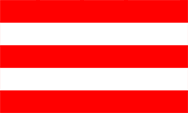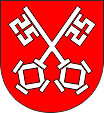Regensburg |
|
|
|
| Übersicht – Contents: | |
Diese Seite ist Teil des Projektes
Regensburg |
|
|
|
| Übersicht – Contents: | |
Flagge – Flag: |
|
 |
1803–1810, Flagge Fürstentum Regensburg – flag Principality of Regensburg, Quelle/Source, nach/by: World Statesmen, Wikipedia (EN) |
Bedeutung/Ursprung der Flagge – Meaning/Origin of the Flag: |
|
| Die Flagge zeigte fünf abwechselnd rote und weiße Streifen. Wahrscheinlich geht die Gestaltung der Flagge auf das Wappen der Stadt Regensburg zurück, das zwei gekreuzte silberne Schlüssel auf einem roten Schild zeigt. | The flag showed five alternating red and white stripes. Probably the design of the flag goes back to the arms of the city of Regensburg, which shows two crossed silvery key on a red shield. |
| Quelle/Source: Volker Preuß | |
Wappen – Coat of Arms: |
|
 |
Wappen Fürstentum Regensburg – coat of arms Principality of Regensburg, Quelle/Source, nach/by: Wikipedia (EN) |
Bedeutung/Ursprung des Wappens – Meaning/Origin of the Coat of Arms: |
|
| Das Wappen des Fürstentums Regensburg ist das der Stadt Regensburg. Es zeigt zwei gekreuzte silberne Schlüssel auf Rot. Das Wappen des Hochstifts (Bistums) Regensburg zeigt auf einem roten Schild eine weiße Diagonallinie von links oben nach rechts unten. | The coat of arms of the Principality of Regensburg is that of the city of Regensburg. It shows two crossed silver keys on red. The coat of arms of the Bishopric of Regensburg shows a white diagonal line from top left to bottom right on a red shield. |
| Quelle/Source: Wikipedia (D) | |
|
|
| Die Landkarte zeigt das Fürstentum Regensburg in der Zeit zwischen 1803 und 1807, in roter Umrandung. | The map shows the Principality of Regensburg in the time between the years 1803 and 1807, within a red border. |
Zahlen und Fakten – Numbers and Facts: |
|
|
|
|
|
|
|
|
|
|
|
Geschichte: |
|
1792, 1796, 1800 und 1805 · Invasionen französischer
Revolutionstruppen unter Napoléon in das Deutsche
Reich, das Deutsche Reich unterliegt und wird von Napoléon territorial
umgestaltet 1801 · alle linksrheinischen Gebiete werden an Frankreich abgetreten und von diesem einverleibt 1803 · Reichsdeputationshauptschluss, Umgestaltung der territorialen Gliederung des Deutschen Reiches, geistliche Besitzungen werden enteignet, alte Fürstenterritorien und freie Städte werden enteignet oder aufgehoben und alten oder neuen Fürstentümern übertragen, die Zahl der Gebietskörperschaften des Reiches wird dadurch von 300 auf 60 reduziert – das ehemalige Fürstbistum Regensburg, die ehemalige Freie Reichsstadt Regensburg, die ehemalige Fürstabtei St. Emmeram, die ehemaligen Reichsstifte Obermünster und Niedermünster, und die Gebiete Donaustauf, Wörth und Hohenburg werden zum Fürstentum Regensburg zusammengefasst, und das Fürstentum wird auf den letzten Kurfürst von Mainz und Reichserzkanzler, dem Fürstprimas Karl Theodor von Dalberg, als Landesfürst übertragen, jedoch erhebt Bayern Ansprüche auf das Gebiet 12.07.1806 · Napoléon erzwingt die Gründung des Rheinbundes, ein Zusammenschluss von sechzehn süd- und südwestdeutschen Staaten unter französischem Protektorat, das Fürstentum Regensburg gehört zu den Gründungsmitgliedern, Fürstprimas Karl Theodor von Dalberg tritt sein Amt in Regensburg an 01.08.1806 · die Staaten des Rheinbunds treten aus dem Heiligen Römischen Reich Deutscher Nation aus 06.08.1806 · Kaiser Franz II. legt die Krone des Heiligen Römischen Reiches Deutscher Nation nieder, das Reich endet 20.04.1809 · österreichische Truppen besetzen die Stadt 23.04.1809 · französische Truppen erobern die Stadt zurück 22.05.1810 · Napoléon übergibt das Fürstentum Regensburg an Bayern, der Fürst von Regensburg wird mit den Gebieten Hanau und Fulda entschädigt, diese werden an das Fürstentum Aschaffenburg angeschlosen und das Großherzogtum Frankfurt gegründet, das Fürstentum Regensburg endet |
History: |
|
1792, 1796, 1800 and 1805 · invasions of French revolutionary
troops under Napoleon in the German Empire, the German Empire subjectes and
becomes territorially transformed 1801 · all left-bank territories of the River Rhine ceded to France, and incorporated by this 1803 · German Mediatisation (Reichsdeputationshauptschluss), transformation of the territorial partition of the German Empire, ecclesiastical possessions become confiscated, old princely territories and free cities become confiscated or dissolved or annexed to old or new principalities, the number of sovereign authorities and territorial entities of the empire is thus reduced from 300 to 60 – the former Diocese of Regensburg, the former Free Imperial City of Regensburg, the former Abbey of St. Emmeram, the former Imperial Abbeys of Obermuenster and Niedermuenster, and the areas of Donaustauf, Woerth and Hohenburg become merged to the Principality of Regensburg, and the Principality becomes handed over to the last Elector of Mainz and Reichserzkanzler, the Prince Primate Karl Theodor von Dalberg, as the sovereign, however, Bavaria raises claims over the territory 12th of July in 1806 · Napoleon forces the creation of the Rhine Confederation, an alliance of sixteen southern and southwestern German states under French protectorate, the Principality of Regensburg is one of the founding members, Prince Primate Karl Theodor von Dalberg takes up his post in Regensburg 1st of August 1806 · the states of the Rhine Confederation declare themselves sovereign and resign from the Holy Roman Empire of German Nation 6th of August in 1806 · Emperor Franz II. lays down the crown of the Holy Roman Empire of German Nation, the empire ends 20th of April in 1809 · Austrian troops occupy the City of Regensburg 23rd of April in 1809 · French troops retake the city 16th of February in 1810 · Napoléon hands over the Principality of Regensburg to Bavaria, the Prince of Regensburg is compensated with the areas of Hanau and Fulda, these become connected to hte Principality of Aschaffenburg, and it becomes established the Grand Duchy of Frankfurt, the Principality of Regensburg ends |
| Quelle/Source: Wikipedia (D) |
Ursprung des Landesnamens – Origin of the Country's Name: |
|
| Der Name "Regensburg" geht auf das im Jahre 179 n.Chr. von Kaiser Marc Aurel gegründete Legionslager "Castra Regina" zurück. Das heißt übersetzt "Lager am Regen". Der Regen ist der Fluss, an dem Regenburg liegt. Die Germanen nannten den Fluss "Regana", die Römer nannten ihn "Reganum" oder "Reganus", im Mittelalter hieß er "Regin". | The name "Regensburg" goes back to the in the year 179 A.D. by Emperor Marcus Aurelius founded Legion camp "Castra Regina". That means "Camp on the Regen". Regen ist the name of the river on which Regensburg is placed. The Teutons called the river "Regana", the Romans called it "Reganum" or "Reganus", in the Middle Ages it was called "Regin". |
| Quelle/Source: Wikipedia (D) | |